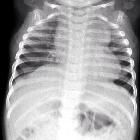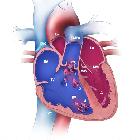CXR approach to congenital heart disease
With the advent of echocardiography, and cardiac CT and MRI, the role of chest x-rays in evaluating congenital heart disease has been largely been relegated to one of historical and academic interest, although they continue to crop up in radiology exams. In most instances a definite diagnosis cannot be made, however, the differential can be narrowed to a few likely diagnoses.
A systematic approach to interpreting pediatric chest radiographs is required. A detailed understanding of the normal contours of the cardiomediastinum on chest radiography is essential if abnormalities are to be detected, as well as knowing the range of normal for pulmonary vasculature marking.
Interpretation is also made significantly easier (and you could argue that it is cheating) if knowledge of whether the child is cyanotic or acyanotic is available.
Step 0: technical assessment
Before you even begin it is essential to assess the technical adequacy of the chest x-ray. The film should not be rotated, over or under exposed and no excessive lordotic or kyphotic angulation should be present. An adequate inspiratory effort must also have been obtained.
Step 1: pulmonary vasculature
Establishing whether pulmonary vasculature is normal, congested (active or passive) or decreased is essential in narrowing the differential.
Normal pulmonary vasculature
Normal vasculature is unhelpful in that it does not narrow the differential. It may represent milder or earlier forms of congenital heart defects, or alternatively represent abnormalities that do not result in altered pulmonary blood flow or pressures, such as simple valvular abnormalities of coarctation of the aorta .
Congested pulmonary vasculature
Congested pulmonary vasculature can be active or passive, and represents increased blood flow and increased pulmonary venous pressure respectively.
Active congestion is therefore seen in left-to-right shunts when right ventricular output is approximately 2.5 times that of the left ventricle . Although the vessels are enlarged, are seen more peripherally than normal and may be tortuous, in contrast to passive congestion the margins remain distinct as there is little interstitial edema.
Passive congestion is due to elevated pulmonary venous pressure and reflects left cardiac dysfunction or obstruction.
Decreased pulmonary vasculature
Oligemia of the pulmonary vasculature represents decreased blood flow through the pulmonary circulation, usually as a result of right ventricular outflow obstruction with an associated right-to-left shunt.
If the proximal pulmonary arteries are enlarged, with pruning of the peripheral vascular markings, then pulmonary arterial hypertension should be considered.
Step 2: aorta
The aorta may be altered in size, location or shape.
Size
The aorta may be normal, increased or decreased in size.
An enlarged aortic knob may represent:
- patent ductus arteriosus (PDA)
- truncus arteriosus
- valvular insufficiency
- severe tetralogy of Fallot
A small aortic knob usually represents reduced blood flow typically due to ASD or VSD. It may also be primarily hypoplastic in hypoplastic left heart syndrome.
Position
Although most right sided aortic arches are incidental with only ~10% being associated with congenital heart disease, in the setting of mirror image branching anatomy the vast majority do have cardiac anomalies, most frequently tetralogy of Fallot .
Shape
The most common abnormality of shape is the so-called figure of 3 sign seen in aortic coarctation.
Step 3: pulmonary artery
The pulmonary artery may be normal, increased or decreased in size.
A small or inapparent pulmonary artery can be due to either it being small secondary to congenital hypoplasia or aplasia, decreased pulmonary flow as a result of pulmonary outflow obstruction as in tetralogy of Fallot, or it being abnormally located as is the case in truncus arteriosus and transposition of the great arteries .
An enlarged pulmonary artery may represent:
- in pulmonary valve stenosis, the left pulmonary artery preferentially dilates due to the orientation of the stenotic jet
- left-to-right shunts
- pulmonary valvular insufficiency
- both the right and left pulmonary arteries will enlarge which distinguishes this from pulmonary valve stenosis; there may also be peripheral pulmonary vascular pruning
Step 4: cardiac size and shape
Finally, the heart itself may be abnormal in size or demonstrate alterations in shape representing underlying chamber enlargement or anatomic anomalies. It is also important to assess for the correct orientation of the heart by looking for the liver/stomach below the diaphragm and reviewing side markers.
Step 5: spine, rib cage and sternum
The vertebrae should be assessed for congenital anomalies including scoliosis which is present in 6% of patients with a congenital heart defect, but only 0.4% of the normal population .
Ribs may demonstrate notching in coarctation of the aorta or maybe only number 11 in patients with Down syndrome . Down syndrome children may also show hypersegmented sternums.
See also
- congenital heart disease
- cyanotic congenital heart disease
- acyanotic congenital heart disease
- plethoric congenital heart disease
- oligaemic congenital heart disease
Siehe auch:
- Aortenisthmusstenose
- Persistierender Ductus arteriosus
- Down-Syndrom
- Atriumseptumdefekt
- Herzfehler
- acyanotic congenital heart disease
- Fallot'sche Tetralogie
- pulmonale Hypertonie
- rechts descendierende Aorta
- Transposition der großen Arterien
- hypoplastic left heart syndrome
- 3-Zeichen bei Aortenisthmusstenose
- Normale Herzkonfiguration im Röntgen-Thorax
- Ventrikelseptumdefekt
- Zyanotischer Herzfehler
- Truncus arteriosus communis
- notching

 Assoziationen und Differentialdiagnosen zu CXR approach to congenital heart disease:
Assoziationen und Differentialdiagnosen zu CXR approach to congenital heart disease:















